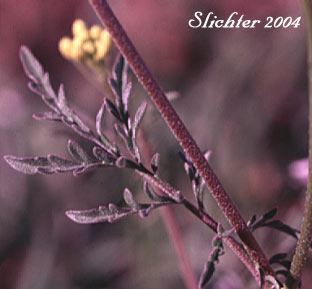

 The
photo at right shows a close-up of a stem leaf of tansy mustard as seen at Horsethief
Butte State Park along the Columbia River in Washington..........March, 2000.
The
photo at right shows a close-up of a stem leaf of tansy mustard as seen at Horsethief
Butte State Park along the Columbia River in Washington..........March, 2000.
Tansy mustard is an annual wildflower with some branching of the erect stems which may rise from 20-100 cm high. The herbage is variable, ranging from green and glabrous to woolly and covered with star-like hairs or with gland-tiped hairs above. The lower leaves are pinnate-pinnatifid while those above are pinnatifid with toothed or lobed margins. The lower leaves measure 2-10 cm long with segments from 1-3 mm wide while those above are reduced in size.
The inflorescence is a dense raceme of pale to deep yellow flowers, the sepals being 1-2.5mm long and the petals from 1.5-3.5 mm long. The slender pedicels are spreading to strongly ascending and measure from 4-8 mm long. The seed capsules are thin, linear siliques from 5-17 mm long and 1 mm wide, which ascend or are erect. The mature pods may often be constricted between seeds.
Ssp. incisa (D. richardsonii var. incisa & sonnei): Plants eglandular. Distributed from central Washington and Oregon south to Mexico and east through Idaho to the Rocky Mts.
Ssp. viscosa (D. richardsonii var. viscosa): Plants stipitate-glandular. Distributed from southern British Columbia south along the eastern edge of the Cascade Mts. to California and east to the Rocky Mts. from Alberta south to New Mexico
Tansy mustard is found on open ground from the lowlands to middle elevations in the mountains.
Tansy mustard is found over much of western North America.